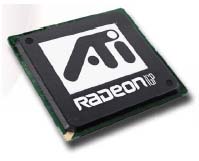The Future of Mobile Gaming: New Chips from ATI and NVIDIA
by Matthew Witheiler on March 13, 2003 8:59 AM EST- Posted in
- Laptops
ATI - Radeon IGP 7000M and Mobility Radeon 9200
The first chip that ATI is announcing today is the successor to the Radeon IGP 340 chipset announced a little less than a year ago. The Radeon IGP 340 served as an integrated graphics solution for Pentium 4 and Pentium 4-M processors and was met with some success in the market. Although not nearly as prevalent as Intel chipset solutions with discrete graphics parts, the Radeon IGP 340 did manage to find its way into a number of computers from large OEMs such as Compaq and Sony.
The Radeon IGP 7000M chipset hopes to further accelerate the adoption rate of the ATI integrated graphics solutions. The chipset has been revamped some increasing performance in both 2D and 3D situations. Aiding performance in 2D mode is DDR333 support (up from DDR266 support in the Radeon IGP 340); the first to be offered in a mobile IGP solution. The memory controller otherwise remains unchanged, meaning it is still a single channel 64-bit controller.
On the 3D side the Radeon IGP 7000M gets a big speed boost thanks to a new graphics core. Whereas the older Radeon IGP 340 included a Radeon VE (aka Radeon 7000) based integrated graphics solution, the Radeon IGP 7000M includes a Radeon 7500 (aka Mobility Radeon 7500, aka M7) based integrated graphics solutions. This raises the bar for integrated video 3D performance up a notch and is a welcome addition to the Radeon IGP line; the upgrade was desperately needed to keep integrated graphics performance somewhat respectable. The use of the M7 graphics core in the Radeon IGP 7000M also means that the chipset gets POWERPLAY support.
We have heard rumors of a second Radeon IGP chipset to be launched later this year, closer to summer time. From what we have been hearing the chipset will serve as a high performance integrated graphics chipset including a higher performing integrated video solution and a faster memory controller. This unannounced product has the potential to make the integrated graphics chipset market all the more exciting but for now the Radeon IGP 7000M will have to do. Note that the Radeon IGP 7000M is pin compatible with the IGP 340, making the transition from the old chipset to the newer one less painful for manufacturers.

The second product that ATI is releasing today is being marketed as a mainstream 3D graphics solution which makes sense being that it is based on the last generation high end ATI mobile chip, the Mobility Radeon 9000. The new chip is the Mobility Radeon 9200, code named the M9+. The Mobility Radeon 9200 is essentially the mobile equivalent of the desktop Radeon 9200, making the chip more or less that same as a desktop Radeon 9000 with AGP 8x support.
The improvements of the Mobility Radeon 9200 over the Mobility Radeon 9000 extend a bit further than those offered by the Radeon 9200 in comparison to the Radeon 9000 Pro. On top of the AGP 8x support, the Mobility Radeon 9200 now comes clocked at a 270MHz core clock speed and a 270MHz DDR memory clock speed (540MHz effective). The Mobility Radeon 9000 that it replaces ran at a 250MHz core clock speed and a 230MHz DDR memory clock speed. Note that in our review of the Mobility Radeon 9000 we were told that a 270/270MHz Mobility Radeon 9000 solution would be offered and sold as a desknote variant of the chip but that product never founds its way to market. It looks like the marketing team decided against creating a desknote version of the M9 (Mobility Radeon 9000) and instead turned the chip into the M9+ (Mobility Radeon 9200).
Although the AGP 8x support on the chip will not result in any performance improvements, the boost in core and memory speed should help make the Mobility Radeon 9200 more competitive in the mobile world by improving upon an already wonderful chip. The chip offers the same POWERPLAY functionality present in the Mobility Radeon 9000 as well.










0 Comments
View All Comments